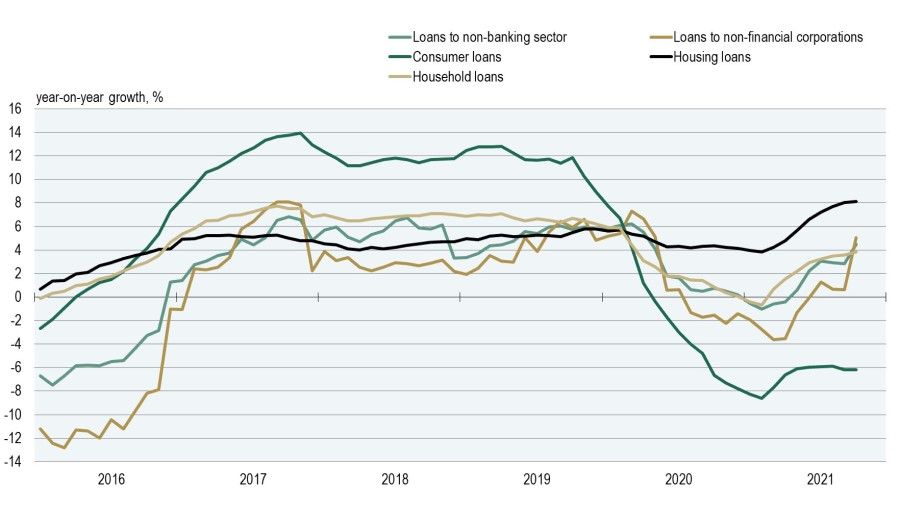The economic situation remains highly favourable at the end of the year, and this is also being reflected in the Slovenian banking system. Banks have expanded their lending activity: year-on-year growth in housing loans increased in particular, while growth in corporate loans also picked up under the influence of mostly one-off factors.
Pre-tax profit remains relatively high in the banking system (at EUR 402 million over the first ten months of the year), the banks having continued to release impairments and provisions. According to the Monthly report on bank performance, the long-term sustainability of profitability at these levels is therefore questionable, given the ongoing decline in net interest income and the stagnation in income.
Pronounced growth in housing loans
Lending to the non-banking sector began to increase in year-on-year terms in the second quarter of 2021, the rate reaching 4.5% by October. Growth in household lending reached 3.8% in October, and was driven primarily by growth in housing loans. Year-on-year growth in housing loans has increased sharply in recent months and reached 8.1% in October, while the year-on-year decline in consumer loans has stabilised in recent months (it stood at 6.2% in October).
Year-on-year growth in loans to non-financial corporations strengthened to 5.1% in October, which was attributable to the relatively low base from last year and major loans to two firms (the rate would have stood at 1.8% in the absence of these two factors). The largest contributions to the aggregate growth came from loans for investment in fixed assets and loans for working capital. The sectors that recorded the highest growth were information and communication, electricity supply and water supply, and construction. Loans to the wholesale and retail trade sector also increased after declining for more than a year, while the stock of loans to the transportation and storage sector continued to contract in year-on-year terms.
After improving in the first half of 2021, portfolio quality indicators at system level have remained broadly unchanged in recent months. The share of exposure with increased credit risk is nevertheless increasing again in certain sectors, most notably in services. Certain segments of the household portfolio have also seen a deterioration in indicators.
Source: Banka Slovenije
Household deposits remain high, despite slower growth
The improving economy also brought a slowdown in growth in household deposits and deposits by non-financial corporations, most likely on account of increased financing of deferred investment and new investment. After a long period of increase, household deposits declined by EUR 132 million between August and October, although their overall increase this year is still significantly larger than the increase in deposits by non-financial corporations.
The banking system saw a slight improvement in its income performance in September and October compared with the summer, although net income in the Slovenian banking system is still stagnating. Net interest income is continuing to decline, although the year-on-year decline is slowing amid the recovery in lending, and stood at 3.3% in October. The net interest margin is also declining, and stood at 1.42% over the last 12 months.
High profits generated by the net release of impairments and provisions
Pre-tax profit remains high, and amounted to EUR 402 million over the first ten months of the year, while pre-tax ROE stood at 9.9%. A major factor in the ongoing high profitability is that 11 of the 16 banks in Slovenia recorded a net release of impairments and provisions. In recent years Slovenia has often been one of the few countries in the EU where the banking system has seen a net release of impairments.
Profitability in the future will largely depend on the stability of trends in income in the banking system, while over the short term it will depend more on developments in net impairments and provisions. Given the further year-on-year decline in net interest income and the stagnation in income, the long-term sustainability of profitability at the current levels remains questionable.
Publication Monthly report on bank performance, December 2021 is available on the link.

